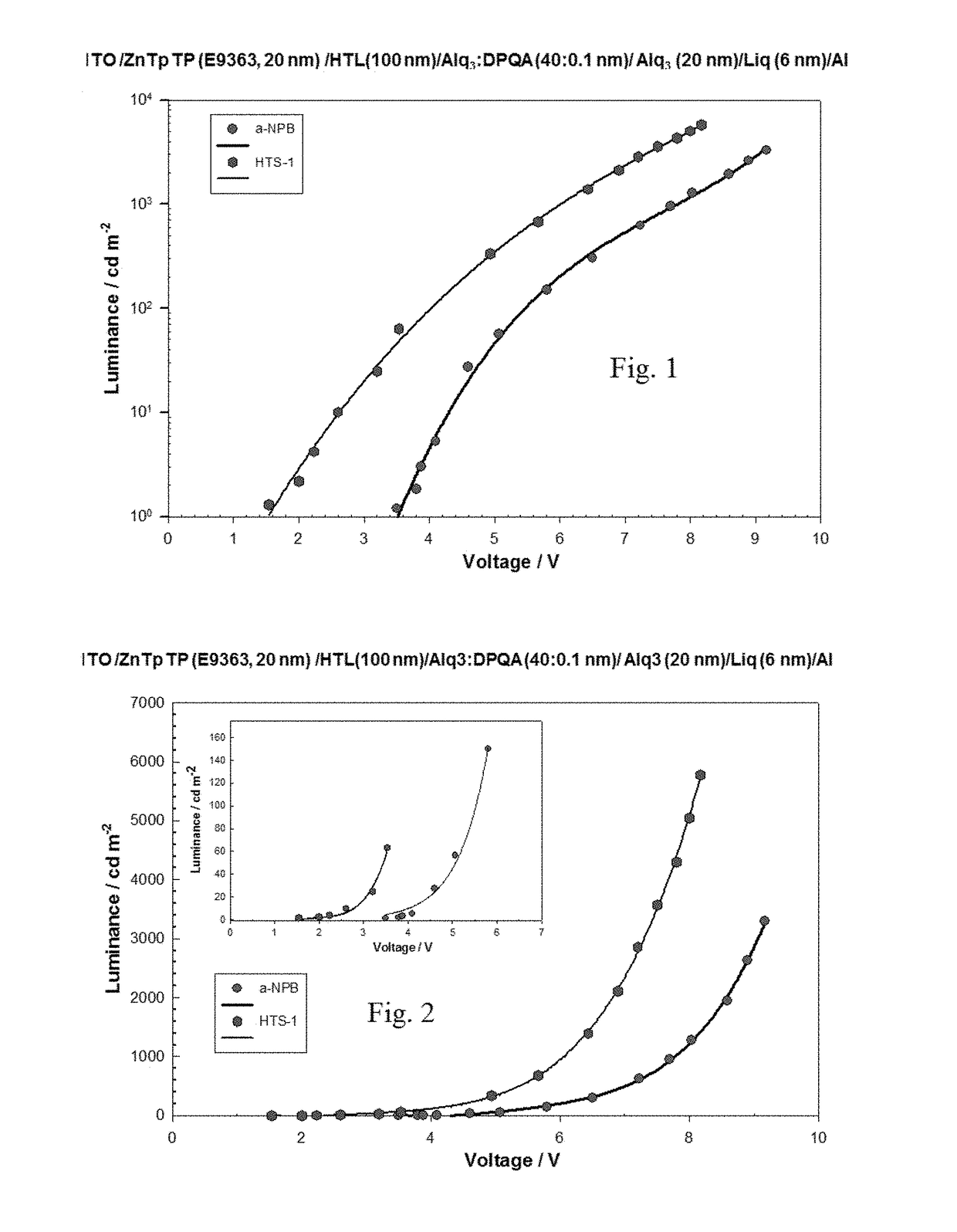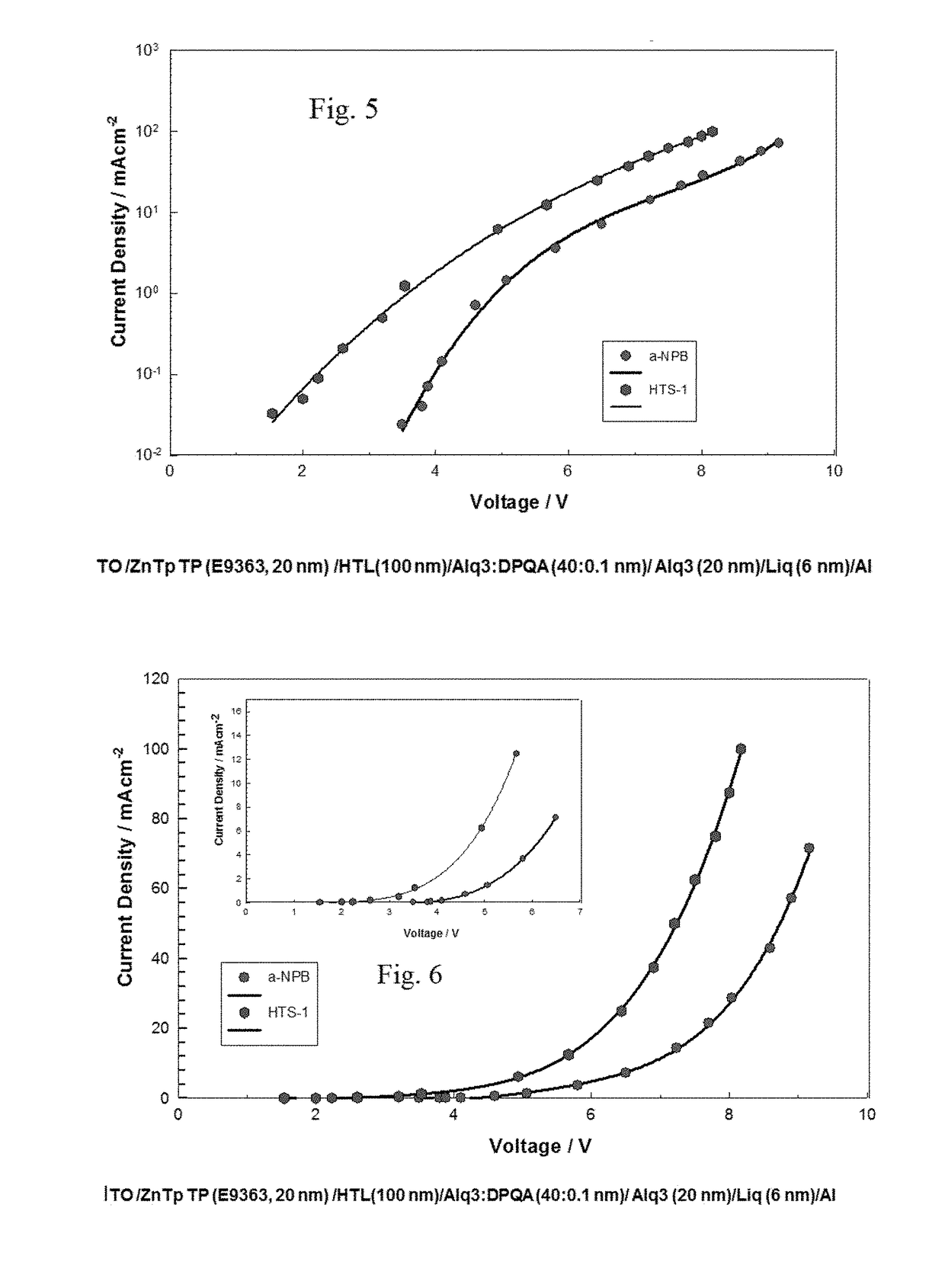Heterocyclic compounds and their use in electro-optical or opto-electronic devices
a technology of electrooptical or optoelectronic devices and heterocyclic compounds, which is applied in the direction of osmonium organic compounds, electrochemical generators, group 5/15 element organic compounds, etc., can solve the problems of low device application efficiency, no hole mobility measurement, and compound performance that is expected to be poor if used as hole transporters, etc., to achieve favourable combination of hole mobility, reduce the number of different materials in different layers that have to be used, and high glass transition temperature or melting poin
- Summary
- Abstract
- Description
- Claims
- Application Information
AI Technical Summary
Benefits of technology
Problems solved by technology
Method used
Image
Examples
example 2
4,4′,4″-tri-(thianthren-1-yl)triphenylamine (also tris-(4-thianthren-1-yl-phenyl)-amine; HTS-2)
[0305]
[0306]To a mixture of tris(4-bromotriphenylamine) (2.0 g; 0.00415 mole), 1-thianthrenylboronic acid (3.6 g; 0.037 mole), tetrakis(triphenyl phosphine) palladium (0.72 g; 0.00062 mole) in ethyleneglycoldimethyl ether (70 ml) was added potassium carbonate (3.0 g; 0.022 mole) in water (50 ml). The reaction mixture was magnetically stirred and refluxed under nitrogen atmosphere for 20 hours, allowed to cool and the solvent removed under reduced pressure. The residue was dissolved in dichloromethane and extracted with brine (The product was not completely soluble in dichloromethane). The organic phase was washed with water, dried over anhydrous magnesium sulphate and solvent removed to give a green solid. To the solid methanol was added, stirred for 6 h and filtered off under suction. The product was washed with diethyl ether and dried under vacuum at 70° C. Crude yield 3.15 g.
example 3
9-(4-Bromo-phenyl)-9H-carbazole
[0307]
[0308]A mixture of carbazole, 95% (5 g; 0.03 mole), 4-iodo-bromobenzene, 98% (16.9 g; 0.06 mole), copper(I) iodide, 98% (2.8 g; 0.015 mole) and potassium carbonate (8.3 g; 0.06 mole) in 1-methyl-2-pyrrolidinone, 99+% (60 ml) was refluxed under a nitrogen atmosphere for 20 h. After 10 minutes the reaction mixture turned blue-green in colour. The solvent was removed under reduced pressure and the residue was dissolved in 1M HCl and extracted with dichloromethane. The red dichloromethane solution was washed thoroughly with brine, water dried over anhydrous magnesium sulphate and solvent removed to give a red crystalline solid which was purified by column chromatography over silica gel (eluent CH2Cl2). The fractions containing the product were collected together and solvent removed to give a red solid. Trituration with petroleum ether gave an off-white solid which was suction filtered, washed with diethyl ether and dried under vacuum at 75° C. The fi...
example 4
4,4′-di-(thianthren-2-yl)triphenylamine(phenyl-bis(4-thianthren-1-yl-phenyl)-amine; HTS-004)
[0316]
[0317]To a mixture of 4,4′-dibromotriphenylamine (5.0 g; 0.0124 mole), 1-thianthrenylboronic acid (7.1 g; 0.0273 mole), tetrakis(triphenyl phosphine) palladium (1.4 g; 0.0012 mole) in ethyleneglycoldimethyl ether (60 ml) was added potassium carbonate (17.2 g; 0.124 mole) in water (40 ml). The reaction mixture was magnetically stirred and refluxed under a nitrogen atmosphere for 20 hours, allowed to cool and the solvent was removed under reduced pressure. The residue was dissolved in dichloromethane and extracted with water. The organic phase was dried over anhydrous magnesium sulphate and solvent removed to give a light green residue which was again dissolved in dichloromethane, adsorbed onto silica gel and then subjected to flash column chromatography over silica gel eluting with dichloromethane. The fractions containing the product were collected together and solvent removed using a r...
PUM
| Property | Measurement | Unit |
|---|---|---|
| glass transition temperature | aaaaa | aaaaa |
| Tg | aaaaa | aaaaa |
| thickness | aaaaa | aaaaa |
Abstract
Description
Claims
Application Information
 Login to View More
Login to View More - R&D
- Intellectual Property
- Life Sciences
- Materials
- Tech Scout
- Unparalleled Data Quality
- Higher Quality Content
- 60% Fewer Hallucinations
Browse by: Latest US Patents, China's latest patents, Technical Efficacy Thesaurus, Application Domain, Technology Topic, Popular Technical Reports.
© 2025 PatSnap. All rights reserved.Legal|Privacy policy|Modern Slavery Act Transparency Statement|Sitemap|About US| Contact US: help@patsnap.com



